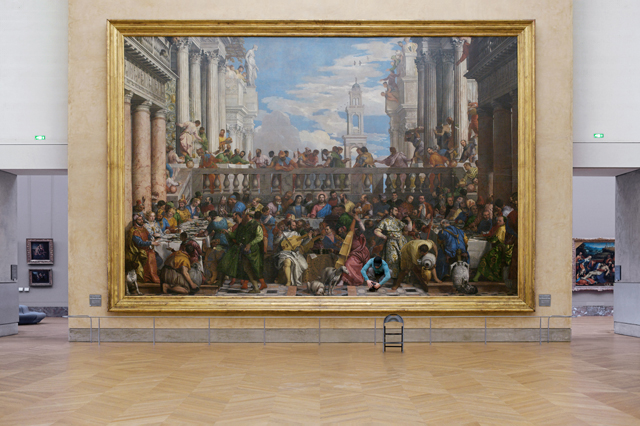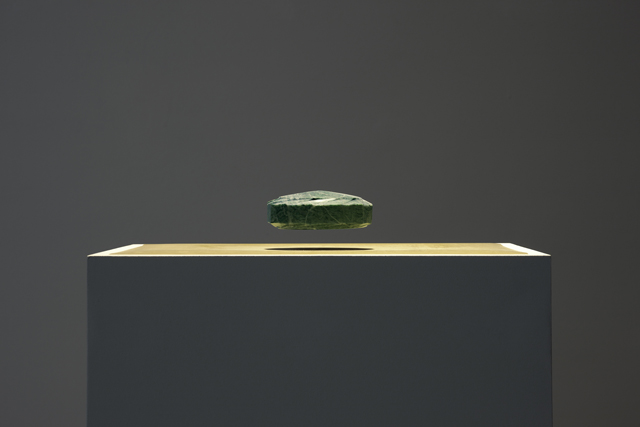Starting in Italian Art History and ending in Loop Quantum Gravity, Luca Pozzi is a product of his background. Working across science, nature and philosophy, the Milan-based artist cites Renaissance artists Tiziano and Leonardo Da Vinci, Mantegna, Tintoretto and De Chirico, Lucio Fontana, Gianni Colombo and many more as influences. That’s while collaborating with the likes of electronic engineer Janick Simeray on levitating sea-sponges in ‘The Star Platform’ and exploring the infinite potential of drawing using experiments by Professor Nicolas Gisin, responsible for teletransporting a photon in 2003, as a jumping off point.
It might look like Pozzi’s sci-art obsession, rooted in the past, is a contradiction in terms but there’s a clear logic to his work, whether it’s a three-dimensional recreation of the mysterious ‘hanging egg’ of the 13th century ‘Montefeltro Altarpiece’ in ‘Schrödinger’s cat through Piero della Francesca influence’ or his Supersymmetric Partner series. The latter features photos of the artist leaping in to the frame of Paolo Veronese’s banquet scenes, making his own pilgrimage into the past, becoming frozen not only in but across time.
“Veronese pushed me to visualize both approaches as the same ‘field’ influenced by different forces, conceived as different grammars,” Pozzi writes, rather lyrically, during a real time Google doc conversation about the evolution of his hybrid practice crossing art and science. “I’m not interested in science in general. I’m interested in Quantum Gravity that is studying the reality at very high energies! This is so far from our scale that is truly poetic”.
Pozzi uses a lot of exclamation marks, and there appears to be a lot that excites him about his work, giving it a sense of awe and ritual that one suspects has a similar effect as the sense of fulfilment you’d get from a more traditional spiritual pursuit. That’s probably why his latest work ‘ORACLE: The Big Jump’ consists a series of performances with a UV laser to occur at sunset (“every day a different question, every day a new ritual in a very special space where our culture was born 2, 000 years ago”). It’s also happens to be a good reason why Pozzi would be such a good fit for the third edition of the Eternal Internet Brotherhood this April.
Counting himself among the handful of net artists travelling to the Dead Sea to explore the metaphysical value of a manmade tool, it makes sense that Pozzi should take his work to a religious crossroads at the centre of disputed territory. That’s particularly when the place where he plans to draw is called Rift Valley, split between territories, in a moment where past and present, the spiritual and political, converge.
It’s interesting you draw from so far back in history. It makes total sense but I’ve heard people from Italy complain how antiquated the country can be culturally. Yet you seem to use that as a catalyst for a practice that is incredibly progressive.
LP: Sure, the point is that if you start to study theoretical physics, looking for the deepest description of our reality, you see that time itself is not just a stage were things happened, it is also an actor. So not working on time but working with time is much more interesting, in my opinion. The best part is that the Italian attitude to this is pretty much familiar and normal, probably because time is something that influenced us lot.
What do you mean by the Italian attitude was influenced by this approach to time?
LP: Dante for example, the creator of our modern language. In the Divina Commedia [The Divine Comedy], he jumps around in history to connect the knowledge that our culture had accumulated in the past centuries…it’s normal! It’s part of us.

It makes sense now that you put it in those terms. Because, visually, there’s a noticeable contrast between something like ‘Dragon’s Eyes’ and the Supersymmetric Partner series but I suppose that juxtaposition, that kind of tear in the fabric of time, is central to your work.
LP: You touch the point exactly. Both works focus on the fabric of time. Supersymmetric Partner is doing this by a citation of a parallel world it’s representing, in an indirect way, using the societal knowledge. ‘Dragon’s Eyes’ is more pure.
The starting point is the Quantum Gravity approach that postulates the existence of time as something that emerges from a quantum fluctuation, in the drawings made by UV light on phosphor [U-Drawings], you are visualizing the building blocks of this fluctuation. It’s made by light that is actually made from quantum particles. At the same time the work is called ‘Dragon’s Eyes’, that actually is another reference to the mythology of the past. So again, it’s playing with what people believe to know.
It’s interesting that you mention the ‘poetics’ of Quantum Theory. I was just watching a video with Metahaven where they talked about the political side of their work but also the “dreamy, romantic” side. They’re interested in conveying, not just information but a clear, lyrical aesthetic as well.
LP: Flatlandia [a Victorian satirical novella exploring dimensions] could help me to answer here. You should imagine a world were things happen only in two dimensions, right? And one day you discover, by looking for a circle that augments its diameter in a very strange and never seen way, the tridimensionality of a sphere. From this ‘natural’ event, you feel that something goes out from your ‘normal’ knowledge.
‘A Square’ tries to convince the people of his country that the reality is bigger than what they supposed but he will be imprisoned because this option is very dangerous. Poetics is another never seen direction. The never-seen direction is revolutionary and, in terms of politics, that makes problems.
So ‘A Square’ in Flatlandia is pretty much Galileo right?
LP: Hehehehe, there are many people in history that are so similar to ‘A Square’, yes! Galileo is one of them for sure. I mean I can’t separate Galileo from Caravaggio. The light on a piece of bread in Caravaggio is the same as the light on the moon of Galileo. They are both poetic because they discovered a different way of using light.

It’s remarkable this persistent human need for reification, despite it being challenged throughout history. It’s like the tragic-comic reality of human existence. We’ll never learn.
LP: Yes, fortunately never. And you know why? The system is always bigger than its constituents. The first question is whether we feel a part of it or outside of it. But it’s incredible that this limit is supported by the amazing capacity of the imagination.
It also exposes this duality (but I wouldn’t want to limit you to two dimensions) that’s so central to your work; this push and pull, a volatility that maintains some sort of core balance.
LP: Yes the core balance, I love it. The fact is that everything happens in a chaotic way but we are created by such an amazing number of connected variables. This connection is a mystery, so strong but at the same time so fragile.
The heaviest particles, for example, they evaporate and collapse in a very short time. But they are part of it, part of the connection between more complex structures. These metastable moments are so important in my opinion and these moments are like key points in the time-line of our evolution. I love to imagine these suspended moments as frozen in time, to visualise them as the final picture.
In terms of ‘post-internet’, I don’t know if you identify with the label yourself, but it’s interesting to note that many artists associated with it tend to have a rather myopic perspective of art history, if any at all. Perhaps that reflects the narrowing effect of networked culture on our subjective experience.
LP: I don’t feel the Internet has a narrowing effect. I look at it as it was originally, as a bridge to share information and to stimulate discoveries. But post-internet is something that will bring us to the future of the Internet, the Quantum Internet!
In that sense, I’m totally with the post-internet generation. I’m looking for a new technology and so a new experience of the Internet, which is much more related to nature and organic substances.

It does feel like your approach is quite unique in a broader context. If you consider the fact that post-internet spans a more diverse demographic, comparative to earlier generations, it makes sense that it would reject a largely patriarchal historical narrative. Is this something you’ve thought about working with and as a direct descendent of artists and theorists that are mostly male?
LP: I can assure you that I used also to discuss and to reference my works also in relation to female scientists like Francesca Vidotto and Fotini Markoupopulo, they are really amazing!
But, yes, if you are talking about my work related to the past, unfortunately our past culture is pretty much monopolised by men. I have to do something explicit as soon as possible in my work to clarify this, because it’s not the result of choices but the result of the past.
I suppose you can’t change the past, so some people choose to disregard it entirely. After all, perhaps our conception of the world would be entirely different if it weren’t for this imbalanced and binary distinction between members of the population.
LP: That’s a good suggestion. I used to work with the past as common knowledge but rewriting history using different markers is probably less powerful in terms of icons, but I love the idea to create new female icons.
When you talk about this cross-disciplinary hybrid art practice, where you draw not only from art and science, but mythology too –while reaching that level of science theory that it becomes transcendental –then the Eternal Internet Brotherhood is a fairly good match for you.
LP: That’s one of the points that usually creates problems between me and the scientists. Most of them are totally far from spirituality, and mythology, and religion. For them those things are the result of ‘small’ behaviours. In my personal opinion our third eye is spiritual and very much related to the capacity that we have to redesign the world, creating imaginative characters.
Mythology and ritual is part of this talent and The Eternal Internet Brotherhood is one of these rituals, it’s part of our natural practice to say that the network is natural.
It’s bizarre that a scientist should be so opposed to the metaphysical, especially considering that science itself has had a history of being persecuted for being a function of the ‘black arts’. It’s just semantics anyway. If you ask me, the nature of the Internet is pretty fucking magical.
LP: I agree, 100 per cent. I think that the problem is that they deny the necessity to postulate the existence of something beyond, but it’s amazing they do that all the time. **













